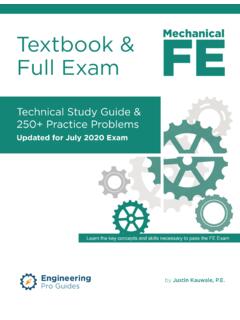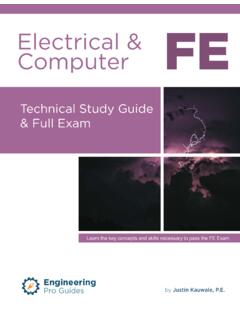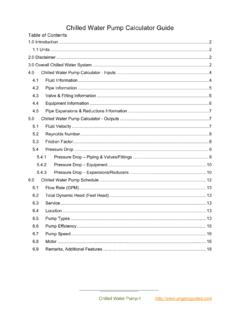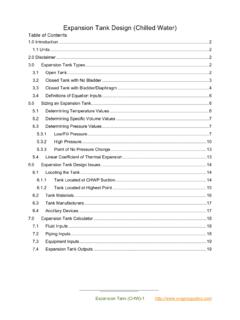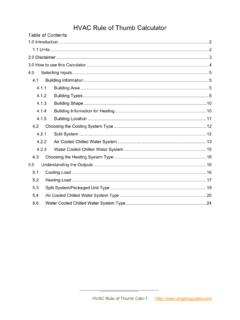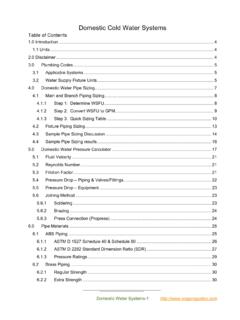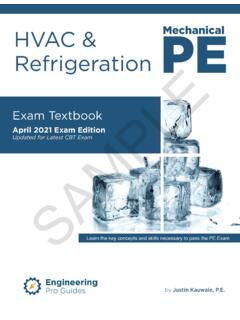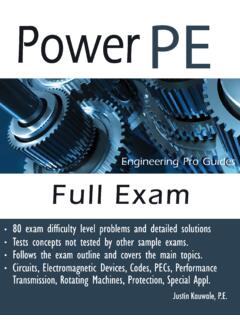Transcription of MechanicalMechanical PE Full ExamFull Exam
1 Justin Kauwale, exam difficulty level problemsMechanicalMechanicalPEFull ExamFull ExamWritten in exam formatCovers Mechanical PE HVAC & Refrigearation exam topicsProEngineeringGuidesAlso includes detailed solutionsHVAC & RefrigerationHVAC & Refrigeration SECTION 1 INTRODUCTION Mechanical PE - HVAC and Refrigeration full Exam Introduction -1 INTRODUCTION One of the most important steps in an engineer's career is obtaining the professional engineering ( ) license. It allows an individual to legally practice engineering in the state of licensure. This credential can also help to obtain higher compensation and develop a credible reputation. In order to obtain a license, the engineer must first meet the qualifications as required by the state of licensure, including minimum experience, references and the passing of the National Council of Examiners for Engineering and Surveying (NCEES) exam.
2 Engineering Pro Guides focuses on helping engineers pass the NCEES exam through the use of free content on the website, and through the creation of books like this sample exam and technical study guides. This sample exam is intended to be a sample test on ONLY the key concepts and skills of the HVAC & Refrigeration Mechanical Exam. KEY CONCEPTS AND SKILLS The key concepts and skills tested in this sample exam were first developed through an analysis of the topics and information presented by NCEES. NCEES indicates on their website that the Exam will cover an AM exam (4 hours) followed by the PM exam (4 hours). Within the Mechanical Engineering field, there are three specialties to choose from for the depth exam: HVAC & Refrigeration, Thermal & Fluids and Mechanical Systems & Materials. This sample exam focuses on the HVAC and Refrigeration topic. NCEES indicates on their website that the HVAC and Refrigeration exam will focus on the following topics: ( ).
3 1) Principles a) Basic Engineering Practice - (4 questions) i) Units and conversions ii) Economic analysis iii) Electrical concepts ( , power consumption, motor ratings, heat output, amperage) b) Thermodynamics - (4 questions) i) Cycles ii) Properties iii) Compression Processes c) Psychrometrics - (8 questions) i) Heating/cooling cycles, humidification/dehumidification, heating/cooling loads, sea level and other elevations d) Heat Transfer - (7 questions) e) Fluid Mechanics - (4 questions) f) Energy/Mass Balances (5 questions) 2) Applications Mechanical PE - HVAC and Refrigeration full Exam Introduction -2 a) Heating/Cooling Loads - (8 questions) b) Equipment and Components - (1 8 questions) i) Cooling towers and fluid coolers ii) Boilers and furnaces iii) Heat exchangers iv) Condensers/evaporators v) Pumps/compressors/fans vi) Cooling/heating coils vii) Control systems components viii) Refrigerants ix) Refrigeration components c) Systems - (18 questions) i) Air distribution ii) fluid distribution iii) refrigeration iv) energy recovery v) control concepts d) Supportive Knowledges - (4 questions) i) Codes and standards ii) Air quality and ventilation iii) Vibration control iv) Acoustics, economic analysis, electrical concepts Each of these topics were investigated and filtered by the test maker for concepts and skills that meet the following criteria: (1) First, the concept and skill must be commonly used in the HVAC & Refrigeration field of Mechanical Engineering.
4 For example, pump sizing, fan sizing, determining friction losses and calculating net positive suction head are regular occurrences in the HVAC & Refrigeration field. The breakdown of question topics is shown in the list above. (2) Second, the skill and concept must be testable in roughly 6 minutes per problem. There are (40) questions on the afternoon exam and you will be provided with 4 hours to complete the test. This results in an average of 6 minutes per problem. This criterion limits the complexity of the exam problems and the resulting solutions. For example, pressure drop calculations are common in the HVAC & Refrigeration field, but the calculation is often very lengthy because of the number of steps involved, especially if a unique fluid and flow condition is used. Thus, common fluids like water/air and common pipe/duct materials are used. (3) Third, the key concepts and skills must be used or be known by practicing HVAC & Refrigeration Mechanical Engineers.
5 This criterion is similar to the first criterion. However, this criterion filters the concepts and skills further by limiting the field to material encountered and used by practicing engineers. The HVAC & Refrigeration, Thermal & Fluids and Mechanical Systems & Materials fields are vast and there are many different avenues an engineer can take. Two diverging paths are those engineers involved in research and those who practice. Mechanical PE - HVAC and Refrigeration full Exam Introduction -3 Research engineers are pushing the boundaries of the field and are highly focused in their specific area of the field. The Professional Engineering exam does not cover emerging technologies or highly focused material. (4) The Exam must test the principle or application of the skill and concept and not the derivations or the background knowledge of the topic or concept. The exam also does not cover background information on the NCEES topics.
6 The Exam is meant to prove that the test taker is minimally competent to practice in the Mechanical Engineering field. The exam is less concerned with theory and more with the principle or application of the theory, skill or concept. For example, the exam is less concerned with the theory of evaporation in a cooling tower and more with the performance and selection of a cooling tower. In summary, this book is intended to provide a sample of the necessary skills and concepts to develop a minimally competent, practicing professional engineer in the Mechanical Engineering field, capable of passing the exam. This book does this through the following means: (1 ) Providing sample problems that can be completed in roughly 6 minutes per problem. (2 ) Providing solutions to these problems that teach skills and concepts used by practicing Mechanical Engineers. UNITS The primary units that are used in the Exam are United States Customary System Units (USCS).
7 As such, this guide focuses exclusively on the USCS. However, it is recommended that the test taker have a conversion book, because certain areas of the Exam may use the International System of Units (SI). DISCLAIMER In no event will Engineering Pro Guides be liable for any incidental, indirect, consequential, punitive or special damages of any kind, or any other damages whatsoever, including, without limitation, those resulting from loss of profit, loss of contracts, loss of reputation, goodwill, data, information, income, anticipated savings or business relationships, whether or not Engineering Pro Guides has been advised of the possibility of such damage, arising out of or in connection with the use of this document or any referenced documents and/or websites. This book was created on the basis of determining an independent interpretation of the minimum required knowledge and skills of a professional engineer.
8 In no way does this document represent the National Council of Examiners for Engineers and Surveying views or the views of any other professional engineering society. HOW TO USE THIS SAMPLE EXAM Mechanical PE - HVAC and Refrigeration full Exam Introduction -4 This exam can be used in multiple ways, depending on where you are in your study process. If you are at the beginning or middle, it can be used to test your competency, gain an understanding and feel for the test format, and help to highlight target areas to study. If you are at the end, it can be used to determine your preparedness for the real exam. Remember that the questions are a sample of the many topics that may be tested and are limited to fit a full exam length and therefore is not comprehensive of all concepts. Because the exam is written to be similar to the difficulty and format of the NCEES exam, it is recommended that the test be completed in one sitting and timed for four hours to simulate the real exam.
9 This will give you a better indication of your status of preparation for the exam. If you are at the ending of your studying, it is recommended to couple this exam with the AM section to simulate the full exam test day. Review the exam day rules and replicate the environment for the real test as much as possible, including the type of calculator you may use and the acceptable references. Keep a watch or clock next to you to gauge your pace for 40 questions in 4 hours. Based on the NCEES website, the following are general rules for exam day. Allowed: 1. Snacks that are not disruptive to others 2. Watches and small clocks (highly recommended on test day, some test facilities do not have a clock) 3. Religious head coverings 4. Two straight edges: ruler, scale, protractor, triangle 5. Approved references 6. Approved calculator (2 recommended for backup) 7. Eyeglasses 8.
10 Non electronic magnifying glass 9. (Units conversion book is also recommended) Prohibited: 1. Cell phones 2. Hats and hoods 3. Slide charts, wheel charts, drafting compasses 4. Weapons 5. Tobacco 6. Personal Chairs 7. Eyeglass/Magnifying glass cases 8. Scratch Paper (all writing must be done in the exam booklet) For additional references on exam day policies, exam day processes, and items to bring on your exam day, review the NCEES Examinee Guide: Mechanical PE - HVAC and Refrigeration full Exam Introduction -5 Similar to the NCEES exam, the tested topics are presented in a random order. For best use of your time, answer the questions that you know first and return to the questions that you are unfamiliar with later. Once all the known questions are answered, go through the test again and attempt to answer the remaining questions by level of difficulty. If time allots, review your answers.
